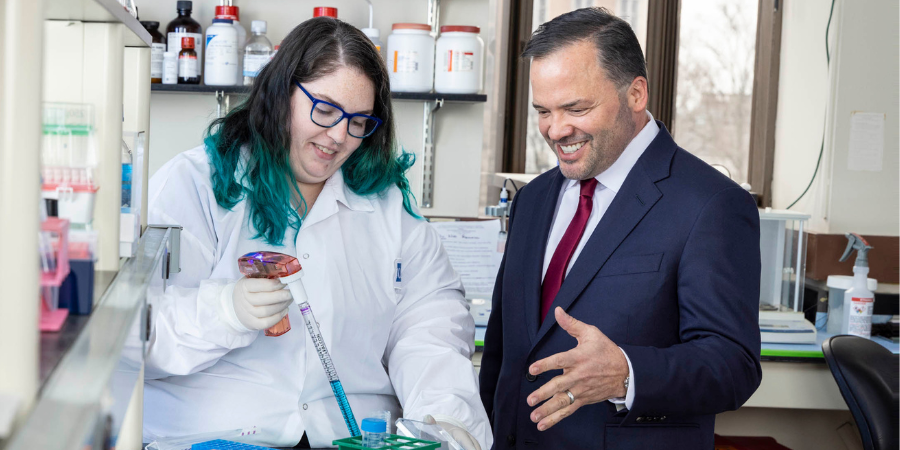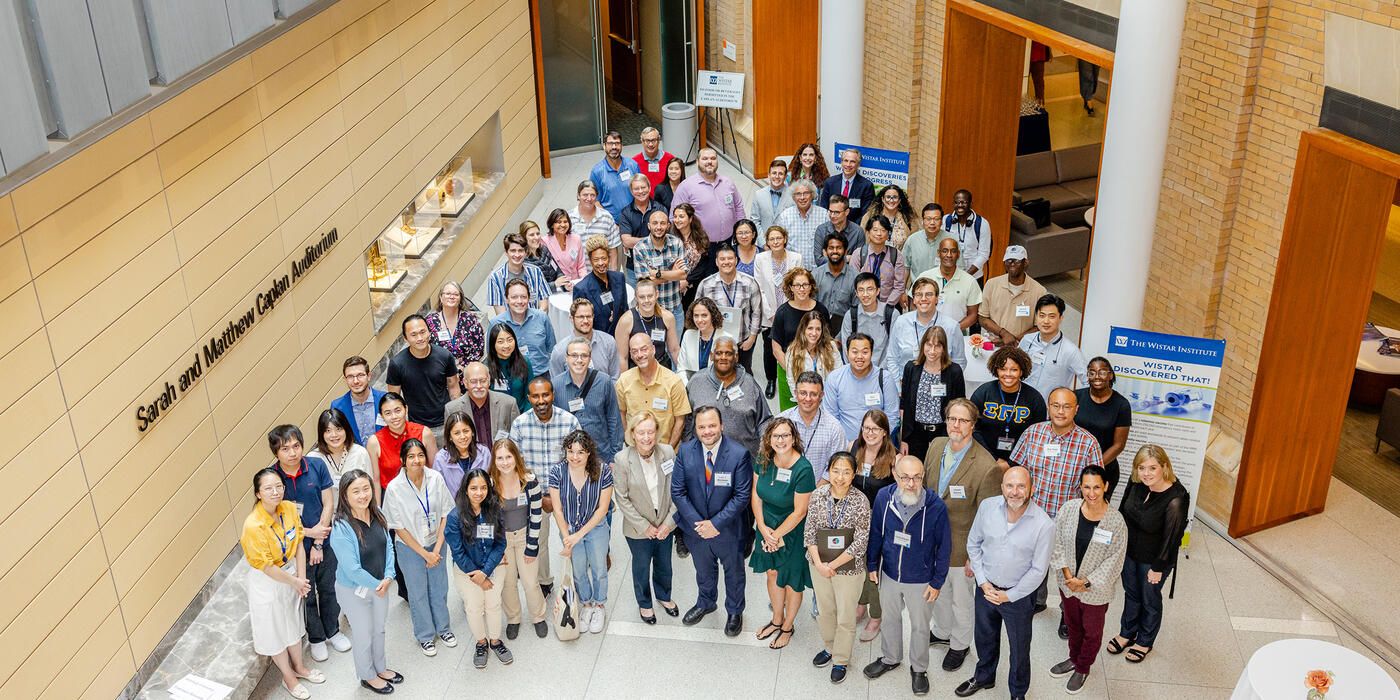Year 29 of the Jonathan Lax Memorial Lecture
This year brought luminary role models—from the clinic to nonprofits—whose mission is advancing an HIV cure and pushing societal change for those living with HIV/AIDS.
The 29th Jonathan Lax Award Lecture at The Wistar Institute celebrated three outstanding health justice champions who have made meaningful impacts in the fight against HIV and AIDS. Richard Jefferys, Basic Science, Vaccines and Cure Project director at the Treatment Action Group (TAG) who gave the keynote speech; Robb Reichard, who led The AIDS Fund, a nonprofit supporting the most vulnerable people living with AIDS in the Philadelphia community; and Dr. Jay Kostman, Philadelphia FIGHT chief medical officer, all started their careers in the 80s and 90s when AIDS just emerged and fear of the disease brought prejudice and stigma. All three men were united in their unrelenting service to the needs of those living with HIV and spoke poignantly about the exact moment they committed to the fight against HIV.
Dr. Jay Kostman shared a visceral memory from his time as a resident at Temple University Hospital—it would set the trajectory of his 30-year career.
“My first experience was taking care of the son of a woman who worked in a Temple University lab. I remember walking into the room—but this was 1984—so you couldn’t just walk into the room of somebody who was thought to have HIV without your spacesuit on,” he said, describing the full body protective gear required to treat those with HIV. “Everybody was worried about what they might be exposed to. The thought of that has stayed with me for 40 years.”
“What must that have been like for this person at a time when HIV was a death sentence? There was no effective therapy. When I saw that young man and saw that nobody else would come in his room and sit with him, that was when I realized this is what I must do, because nobody should be treated like this.”
Robb Reichard was honored for his 20-years of advocacy, raising $18.5 million for HIV care. He shone the spotlight on those who supported him.
“I have always been surrounded by good people. In the early 1990s the LGBTQ+ Community Center offered a workshop addressing homophobia that I wanted to attend, but couldn’t afford, so my friend David paid that registration. The tools I learned in that workshop have been invaluable to me over the past 35 years.”
He went on to salute friends at all stages of his career, from a past executive director and board members to many hardworking and committed coworkers and volunteers who stood side-by-side with him during his tenure.
“I was surrounded by some incredible coworkers who worked far too hard for far too little. I could tell you so many stories about their commitment. For 12 years our offices occupied a space that had neither central heat nor central air. In the winter it was not unusual to find a coworker sitting at their computer in a winter coat and fingerless gloves so they could type. Of course, none of this work could have been done without the literally 1000s of volunteers who gave their time and energy over the years, and so many of you are here tonight. I’m not going to be able to mention you all but thank you so much.”
In his keynote speech Richard Jefferys said he got started in advocacy like many—after his friend was diagnosed. “I wanted to find information and got connected to an organization called the AIDS Treatment Data Network, founded by an incredible woman named Eleanor Mitchell.”
Via mail he received a directory of every state’s ADA—AIDS Direct Assistance Program—for uninsured and underinsured people.
“The Administration was going to stop making this directory and we felt we should create a resource to inform people. We called every state to create a database of treatments, Medicaid programs, prior authorization requirements and created a website as soon as that was possible and we issued our first report in September 1995. The findings were appalling in that Georgia had four drugs available for people, whereas New York had scores. There were disparities all around the country. We realized quickly that with new treatments coming, these programs are going to be essential and need more funding.”
Each year the Lax Lecture is a powerful symbol and reminder to all that their dedication and shared mission to discover scientific answers, provide services, raise awareness, and fight for funding & support for HIV is bigger than the sum of its parts. This year’s Lax Lecture brought together a powerful trio sharing personal histories to emphasize the importance of community engagement and scientific collaboration in HIV research. Thirty years ago was the height of the AIDS pandemic, but thanks to the efforts and commitment of this community, we’ve progressed to the height of scientific inquiry and discovery, with sights set on an HIV cure.
Side Bar:
For the past 29 years the Jonathan Lax Memorial Lecture highlights pioneers advancing the field of HIV research with an annual lecture spotlighting cornerstone research studies and exciting new science poised to dramatically change the HIV status quo. The Lax Lecture’s success is due to the community’s role and long-term support of science and to donor support that is accelerating the changing course of HIV.
Donor Ken Nimblett has the vision and foresight to understand that today’s research will lead to tomorrow’s cure. He’s attended numerous Lax Lectures and funded Wistar HIV research over the decades. Together with his late husband Rusty Miller and Rusty’s late mother Martha Stengel Miller, the Summerhill Trust was established in part to fund cutting-edge HIV research.
This year was extra special to Ken because a panel from the AIDS Memorial Quilt was on display at Wistar during the Lax Lecture. Dr. Luis Montaner, Wistar EVP and director of the HIV Cure and Viral Diseases Center, and Mr. Reichard located the panel in a Los Angeles archive and had it delivered to Wistar. More than 50,000 panels form the AIDS Memorial Quilt, which features more than 110,000 names. Ken and his mother created a panel for Dave Giuliana, his partner, who died in 1988.
“It is incredibly moving to see Ken and his mother’s loving contribution—a tribute created at a time when so many young lives were lost to AIDS before therapies were available,” said Dr. Montaner. “I am honored that we are able to celebrate Dave’s life and legacy at Wistar, in the presence of the scientist teams working toward a cure. The quilt’s presence—and especially Ken and Dave’s story—will be a powerful reminder and inspiration of why this pursuit must go on.”
Ken and Dave made the trip in 1987 to Washington D.C. to see the AIDS Memorial Quilt on display for the first time on the National Mall. This coincided with a National March on Washington for Lesbian and Gay Rights. The Quilt has been displayed in its entirety five times at the National Mall with 1996 being the last time it was exhibited in its totality of 41,000 panels. Today, there are still volunteer opportunities to make a panel or repair the Quilt and ensure its legacy lives on.
“I have a number of photos of the AIDS Memorial Quilt in 1987 on the Mall in D.C. that Dave and I went to see and experience,” says Ken. “It was an emotionally difficult experience as we knew some of the people who had been memorialized with a panel showing something of their lives as each one was such a very personal expression of who they were. Dave and I also knew that one day he would likely be gone and I would be left to make a panel for him, which I did.”
View a photo gallery of the event here.











